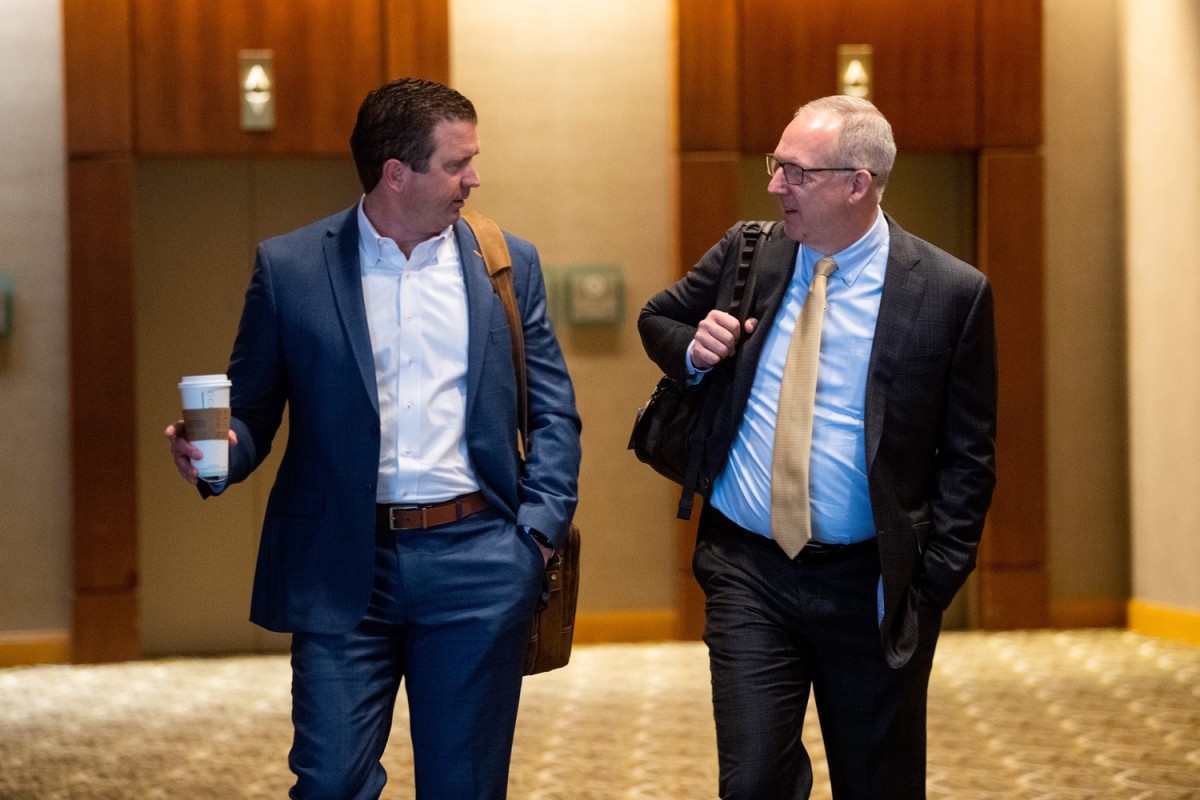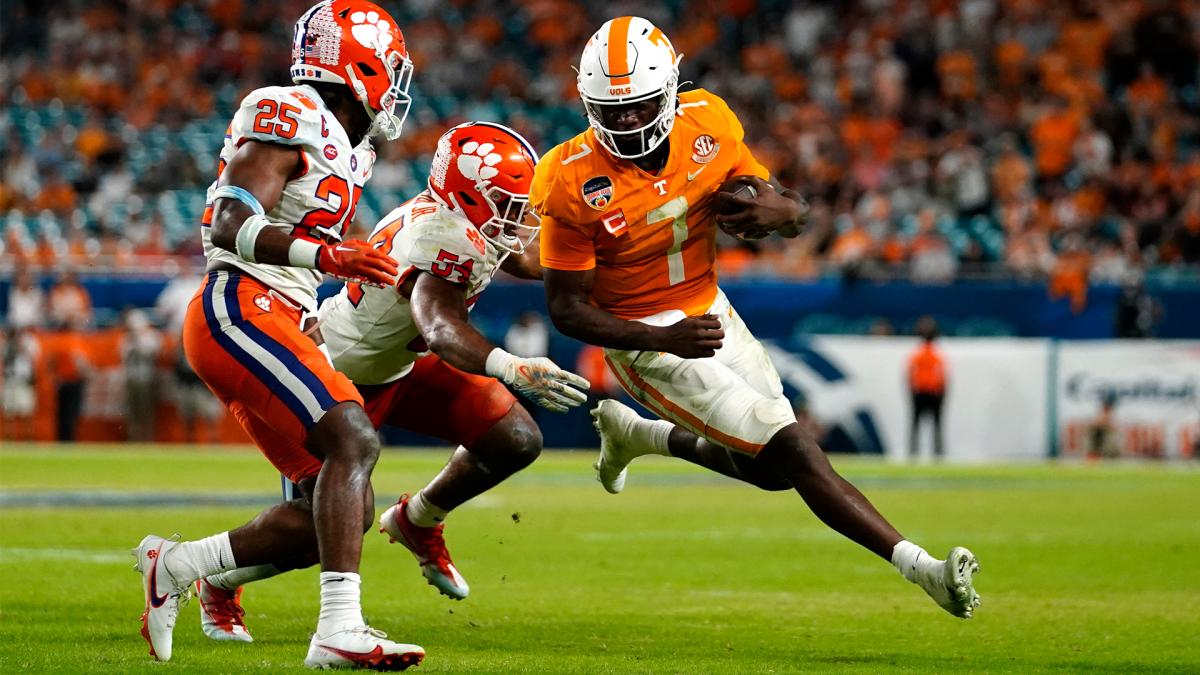In College Athletics, ‘Employment’ Is a Dirty Word. SEC Leaders Are Looking for an Alternative

This is Part 2 of a two-part series exploring the SEC’s most pressing issue, as its member schools begin to use their fundraising arms (foundations) in NIL endeavors. While Part 1 examines the trend and its problems, Part 2 explores potential solutions to the issue.
On June 6, dozens of SEC administrators and coaches will descend on Capitol Hill to further lobby state lawmakers to push through legislation governing athlete compensation.
College leaders want a federal bill to (1) standardize NIL by preempting state laws; (2) deem college athletes as students, not employees; and (3) provide liability protection from legal challenges. In four years of this lobbying effort, eight hearings have been held and more than a dozen college athlete bills have been introduced.
The number of proposals to clear a House or Senate committee: zero.
“It’s easier to stop legislation rather than pass it,” says Mississippi State president Mark Keenum, who spent years as the chief of staff for former Mississippi Senator Thad Cochran. “You’ve got to have something pushing Congress. I hate to say it, but there almost has to be some catastrophic event for Congress to react.”
What if congressional action fails?
For a year now, the SEC’s most powerful executives have explored solutions with a goal of managing athlete compensation in a more regulated way, if a federal solution is not achieved. During Day 1 of their annual spring meetings on the Florida panhandle, their Plan B is coming into focus.
The league expects to align its 12 state NIL laws in an effort to hand power to the conference office to oversee, police and even set policy for NIL.
“We have enough trust and confidence from our state leaders that we can govern ourselves if that needs to be done,” SEC commissioner Greg Sankey said.

In a tiff of irony, the SEC’s backup plan is to put trust in state lawmakers who, through a bevy of recent state laws, have splintered the conference.
The latest wave of state statutes in Missouri, Arkansas, Texas and Oklahoma bar NCAA and SEC enforcement as well as clear a path for schools to operate NIL collectives from beneath their own fundraising arms—an issue explored in a story Sports Illustrated published Tuesday. Operating NIL through a school’s foundation risks Title IX violations, brings athletes closer to employment and puts schools in states without such ability at a disadvantage.
This latest evolution of NIL collectives has frustrated administrators, riled up coaches and sparked conversation about a future, more regulated model for athlete compensation, such as employment.
“Unionize it. Make it like the NFL,” Alabama football coach Nick Saban said Tuesday. “If it’s gonna be the same for everyone, I think that’s better than what we have now.”
Most agree that college sports is barreling toward a semiprofessional model that features some sort of school pay. Even those outside of the SEC can see that.
“I wish we would stop hiding behind NIL,” UNC coach Mack Brown says. “We are headed toward an NFL model.”
Stuck in a sort of purgatory between amateurism and professionalism, college athletics seem to be crawling incrementally toward a more regulated compensation framework. Many believe that it’s time to get there as soon as possible. And if leaders within college athletics don’t make the decision themselves, then an outside entity will make the decision for them.
Several pathways to a new college compensation model are in the process of working their way through the judicial, legislative and executive branches of government. In the courts, a case in Pennsylvania (Johnson vs. NCAA) could deem athletes as employees. At the state legislative level, a bill in California would require schools to share revenue with athletes. And at the executive level, the National Labor Relations Board is on the way to ruling athletes as employees.
That doesn’t mention two lawsuits against the NCAA—House vs. NCAA and Hubbard vs. NCAA—that could leave the association buried in billions of fees and penalties.
Some within the industry are beginning to come to grips with a new athlete compensation model in the future.
“We are the least regulated sport in the world,” Tennessee athletic director Danny White said in an interview with Sports Illustrated in March. “I’m not stuck in the old model. We need to accept and embrace the new reality. Instead of fighting it, let’s accept it and get it organized.”
These days, many college leaders tend to shy away from what has developed into the latest controversial word inside the industry: employment. Most college administrators are dodging employment questions, singing a doom’s-day tune about an athlete employment model and attempting to avoid it as long as possible.
Others believe it is time for this quasi-professional model of college athletics to fast forward to the eventuality. It’s time for revenue sharing. It’s time for employment.
“That’s clearly where this is heading,” says Michael Leroy, an Illinois law professor who has published extensive work on labor policy.
Leroy believes a school’s fundraising foundation involving itself in NIL is already towing the line of employment. He compares this era of college sports to the 1960s and ’70s of professional sports, when leagues created unions and bargained collectively with their players.
“The days of cheap labor of college athletics is coming to an end,” he says. “Right now, Power 5 schools spend about 15% of budgets on athletic scholarships, compared to NFL players who are getting 50%. The needle is going to start to move.”
For the most part, the powerbrokers of college athletics are pushing back against this move, and they are seeking congressional help to do it.
But without a federal solution, the SEC may go it alone, so to speak, creating their own 12-state, 16-school NIL model based on state laws that mirror one another. Alas, there are problems with this. Newly amended laws in Texas, Oklahoma, Missouri and Arkansas prohibit enforcement of outside entities such as the SEC.
Sankey is baffled by such a provision in these bills.
“I don’t understand that reaction,” he said. “I know legislators get angry at the NCAA, but a notion that a voluntary association’s leadership can’t come together and set standard is one that is way, way out there from how we conduct our business.”
Can the SEC really police and/or oversee NIL within the league? Can it create its own NIL policies?
Georgia president Jere Morehead, the leader of the SEC executive council, fears that it will end in further litigation without antitrust protection from Congress. But, he adds, “we will have to consider those options if we are not successful in Washington, D.C.”
Other options have been and are being discussed.
Officials have examined expanding the Alston payment. Stemming from the 9-0 Supreme Court loss in 2021, schools can provide athletes about $6,000 a year in education-related money.
Could schools find a way to provide more payments to athletes directly from the institution? This could diminish the need for NIL, curry favor with politicians and potentially appease some of the court pressures.
Instead of $6,000, could schools pay athletes $16,000 a year? How about $30,000?
“What is fair?” asks Keenum. “Who determines that?”
Any expansion of Alston—or any other direct school pay—could backfire for administrators. The controversial word—employment—was at issue during a near years-long meeting of the Transformation Committee, a group of school administrators co-chaired by Sankey himself that was commissioned by the NCAA in January 2022 to modernize rules.
The risk of employment kept the committee from recommending more athlete pay.
“We are open to a lot of different ideas as long as we do not cross the threshold of making student-athletes into employees,” says Morehead. “If an institution signs a revenue-sharing agreement with a student-athlete, that sounds like a business deal to me. We need to carefully think through to the end game and make sure we do not turn our student-athletes into employees.”
The Transformation Committee did approve the concept of graduation bonuses. It is advancing through the system, Morehead says.
“Why not create graduation bonuses instead?” he asks. “We need to tie the things we want to do as institutions to our objective of increasing retention and graduation rates for student-athletes.”
On Tuesday, officials discussed the lingering employment issue.
Ole Miss football coach Lane Kiffin has supported an employment model rather than the current structure of NIL. But he learned more about the consequences of athlete employment during conversations with Sankey and other conference administrators.
“I’ll admit, I’m not educated on what things come with that,” he said. “Labor, school, university and all that. That’s much more complicated than saying ‘Well! They are employees.’ The statement [today] said, ‘You solve these six problems, but you open up six pages of problems.’”
So what’s the solution?
“I don’t know anybody has that answer of what to do,” says Kiffin. “They know what they don’t like. We all know that, but no one really has the answer of what exactly to do.”

No matter what happens to the future of athlete pay—revenue-sharing, employment or a foundation’s involvement—the role of booster-led collectives isn’t disappearing.
In a similar way to professional athletes earning marketing and promotional dollars in addition to their salaries, collectives are prepared to distribute extra cash to athletes. And what if the trend continues of nonprofit school foundations having a role in NIL?
Nonprofit organizations are not able to strike deals with car dealerships and other businesses for profit, says Mit Winter, a sports law attorney based in Kansas City.
“You’re still going to have collectives doing those types of things,” he says.
In a search for answers to the current situation, Clemson football coach Dabo Swinney, among many others, believes a new association is the answer.
“We need to blow it all up and have a new governance structure,” he says. “We need a governance structure that’s reflective of real-time issues.”
Many have suggested the College Football Playoff as that new association. The thinking: A subset of like-minded schools in FBS—most or all of the Power 5—would move under the CFP with a new set of standards of practice.
Keenum, the chair of the CFP executive board, cautions this approach.
“The CFP is not a governing body. It is an event organization,” says Keenum. “You could create another NCAA. How do you do that and get all the other members to come to the table? You won’t get all the current members to come to the table. Is there a breakaway? You’re posing something that conceptually could happen, but I don't know realistically any time soon.”
For now, the old model plods along. Except, of course, in the SEC.
This football-crazed, money-driven, competitive group of neighbors are waging their latest proverbial war on one another by creating a system of athlete pay operated from a school’s foundation.
Soon, without a federal solution, the SEC believes it has its own fix: govern NIL itself.
Will it work? How will it work?
As Sankey walked out of interviews earlier this week, he shrugged at the questions.
“We’ve got to figure that out,” he said, smiling.
